Table of Contents
Introduction
Arabic Peacock Mehndi Designs have become a favorite among young brides, festival-goers, and trendsetters for their unique blend of bold Arabic patterns and the timeless beauty of the peacock motif. I first discovered this style at a Diwali party in Mumbai, where a friend had a sleek, flowing peacock design that everyone loved. The look is captivating yet minimalist. The peacock’s fanned tail and delicate feather details offer a fresh twist on traditional henna art.
In this article, you will find dozens of Arabic Peacock Mehndi Designs from our catalog along with a discussion on how these designs emerged as a fusion of Middle Eastern simplicity and Indian cultural symbolism. You’ll learn about the evolution of the style, its key characteristics, and the techniques that bring out the best in every design. Whether you’re a beginner looking to experiment or a just henna art lover, this guide will help you appreciate the magic behind Arabic Peacock Mehndi. Expect a mix of practical tips, personal insights, and creative ideas to try on your next mehndi session.

If you’re interested in other mehndi options then check out our articles on Arabic Rose Mehndi Designs and Arabic Full Hand Mehndi Designs. For a high level overview see our article on Arabic Mehndi Designs.
Background & Key Characteristics

Arabic mehndi traditionally stands apart with its open, flowing lines and deliberate use of negative space. Unlike the heavily filled Indian bridal mehndi, the Arabic style embraces bold, sweeping outlines that create an airy feel. The peacock motif in these designs serves as the star element, symbolizing beauty, grace, and good fortune in Indian culture while also resonating with modern aesthetics.
What makes Arabic Peacock Mehndi unique is the fusion of two worlds. On one hand, the Arabic influence contributes large, uncomplicated floral and geometric patterns. On the other, the peacock—India’s national bird—is drawn with intricate feather details, often using dotted accents to mimic the “eyes” on its feathers. This mix provides a design that is both elegant and eye-catching, ideal for festive occasions and modern weddings. The strategic use of empty space not only speeds up the application process but also creates a chic, minimalist look that appeals to a young audience looking for something fresh and contemporary.
Design Elements & Techniques
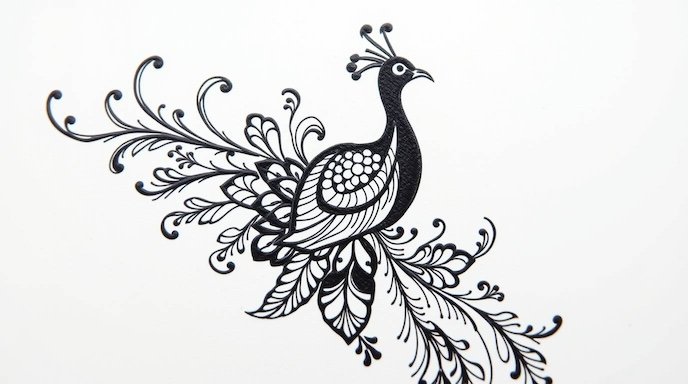
Creating an Arabic Peacock Mehndi design requires a blend of artistic flair and technical precision. First, the design is characterized by bold outlines. Artists use henna cones to trace thick, confident lines that form the peacock’s body, head, and fanned tail. These outlines are complemented by flowing Arabic floral motifs, where each swirl and dot is carefully placed to enhance the central peacock figure.
One popular technique is the use of negative space. Instead of filling every inch with intricate patterns, many artists leave intentional gaps. This approach highlights the main elements, especially the peacock’s feathers, and gives the overall design a light, almost lace-like appearance. In practice, you might see a large, elegant peacock with its head positioned near the thumb and its tail gracefully sweeping toward the wrist, while the rest of the hand remains largely untouched.
Shading is another key element. Traditional Arabic mehndi uses natural henna’s varying color intensities to create a two-tone effect. Some artists manipulate the paste thickness or use subtle brushing techniques to generate gradients within the peacock’s feathers, adding depth and a sense of realism to the design. For example, the base of a feather might be left lightly stained, while the edges are pressed with more henna to produce a darker, more defined look.
Intricate detailing comes into play when decorating the peacock’s tail. Fine dots, teardrop shapes, and tiny swirls fill the interior of each feather, echoing the natural pattern of a real peacock’s plumage. This level of detail requires both a steady hand and practice; many artists start with simple outlines on paper before attempting the full design on skin. A common tip I’ve learned is to work continuously without lifting the cone too often. This not only keeps the lines smooth but also helps maintain consistency in the pattern.
Artists also use additional tools such as stencils for beginners or decorative brushes to apply a light dusting of henna for shading. The goal is always to achieve a balance between boldness and delicacy. The design should be striking from a distance yet reveal subtle intricat details up close.
Below are some samples of Arabic Peacock Mehndi Designs from our collection. Click the image to expand it and print a copy that can be used as a pattern. These probably wouldn’t be recommended for a beginner to try, but they can be used as inspiration. Use them to create something unique and beautiful for you.


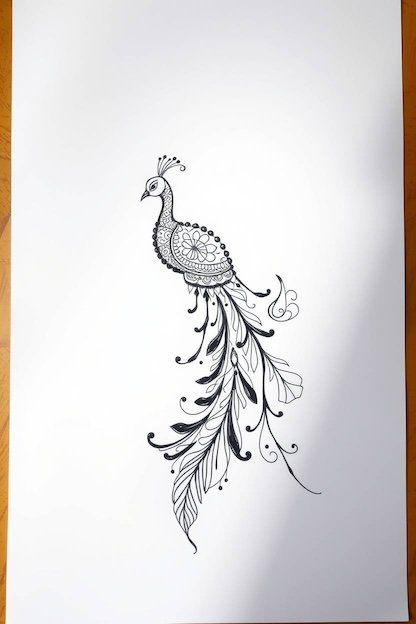





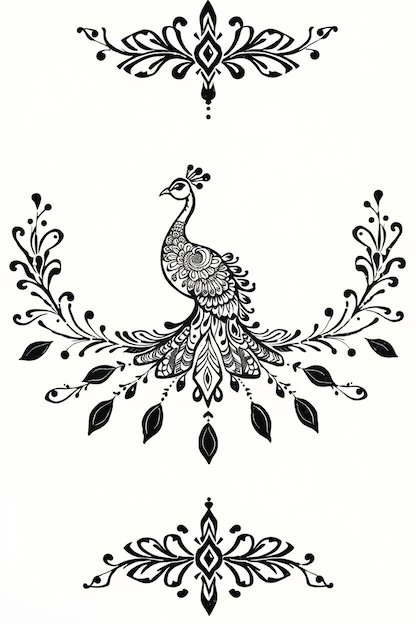



Step-by-Step Tutorial: Creating a Stunning Arabic Peacock Mehndi Design
For those looking to create their own Arabic Peacock Mehndi design, here is a simple yet detailed step-by-step guide. Whether you’re a beginner or a seasoned henna enthusiast, these instructions will help you achieve a beautiful, balanced look.
1. Prepare Your Tools and Skin
Ensure your henna paste is fresh and smooth. Use a high-quality henna cone with a fine tip for precise lines. Clean your skin with a gentle cleanser and dry thoroughly. A quick tip: practice the design on paper first to get comfortable with the flow of lines.
2. Sketch the Main Peacock Outline
Start by drawing the peacock’s head and body. Create a small oval or teardrop shape for the body and extend a graceful curved line upward to form the neck and head. Add a small dot for the eye and a gentle curve for the beak. This initial sketch serves as the anchor for your design.
3. Design the Dramatic Tail
From the bottom of the body, draw a series of large, fanned-out shapes representing the tail feathers. Aim for three to five overlapping feathers. Each feather should have a broad base that tapers to a fine point. Use bold, continuous strokes to ensure a confident outline.
4. Detail the Feathers
Once the outline is complete, add internal details to the feathers. Draw smaller teardrop shapes or “eyes” inside each feather. Fill these with dots and delicate lines to mimic the intricate patterns of a real peacock’s plume. Alternate between solid and outlined feathers to create a dynamic contrast.
5. Incorporate Arabic Floral Motifs
Enhance the design by adding flowing Arabic floral patterns around the peacock. Draw swirling vines that extend from the main motif, interspersed with small flowers or paisleys. These accents should complement the peacock without overwhelming it. Maintain ample negative space to keep the design airy and modern.
6. Refine and Emphasize with Negative Space
Review your design and decide where the empty spaces can accentuate the main elements. Clean up any stray lines and ensure that the peacock and surrounding motifs have enough breathing room. This step is crucial for achieving that signature Arabic look.
7. Final Touches
Add any extra dots, small swirls, or lines to refine the overall composition. Some artists like to add minimal detailing on the fingertips or along the sides of the hand to connect the design seamlessly. Use a steady hand and take your time.
8. Drying and Aftercare
Allow the paste to dry for at least 10–15 minutes. To intensify the stain, some recommend gently applying a lemon-sugar mixture to seal the henna. Keep the paste on for 6–8 hours (or overnight for best results) before gently scraping it off. Avoid washing the area immediately to let the stain deepen over the next 24–48 hours.
This step-by-step guide is designed to be easy to follow while highlighting the distinctive aspects of Arabic Peacock Mehndi Designs. Experiment, have fun, and remember that every artist’s style is unique. With practice, your designs will grow as bold and beautiful as the peacock itself.
Variations and Popular Trends
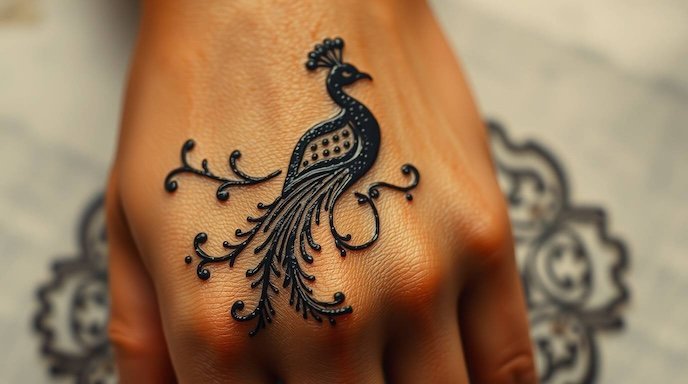
Today, Arabic Peacock Mehndi Designs are evolving as artists merge tradition with modern creativity. One popular trend is the fusion of Arabic and Indian styles—known as Indo-Arabic mehndi. In these designs, the characteristic bold outlines and spacious layout of Arabic mehndi are filled with intricate Indian details. This creates a design that is both modern and deeply rooted in cultural symbolism. For example, you might see a large, elegantly outlined peacock with delicate mandala patterns or tiny floral motifs filling the spaces within its feathers.
Another trend is personalization. Many young brides now request designs that include subtle elements like initials, dates, or even a tiny symbol that represents a personal story. The versatility of the Arabic style makes it easy to add these extra touches without disturbing the overall balance. Minimalist designs are also gaining popularity, where a single peacock feather is used as a statement piece on a bare hand or wrist. This style is perfect for casual festive occasions or even for those new to mehndi art.
Modern techniques have also introduced embellishments like glitter or metallic foils that can be added after the henna paste is applied. These accents provide a contemporary twist and make the design sparkle under bright lights at events like Sangeet nights or Diwali parties. Although these embellishments are temporary, they add a modern flair that complements the traditional aspects of the design.
Overall, the trend is toward creating a dialogue between past and present—a design that honors cultural heritage while embracing innovation and personal expression. This blend of tradition and modernity is what keeps Arabic Peacock Mehndi both timeless and trendy.
Below are more samples of Arabic Peacock Mehndi Designs from our collection.
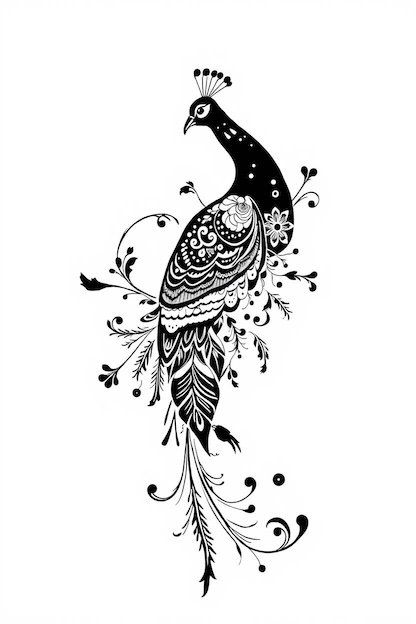







Cultural Inspirations & Symbolism
The cultural significance of Arabic Peacock Mehndi Designs is multifaceted. In Indian traditions, the peacock is a revered symbol of beauty and grace. It represents a promise of prosperity and joy. Qualities highly valued in weddings and festivals. I’ve often heard elders share that a well-done peacock mehndi design can bring blessings and protect against the evil eye.
In Middle Eastern cultures, henna has been used for centuries as a sign of celebration and protection, though the peacock is less common historically. Today, however, the modern Arabic style readily incorporates the peacock as a sign of elegance and cosmopolitan taste. In fusion contexts, the peacock stands as a bridge between different cultures, blending Indian symbolism with Arabic design aesthetics. This synthesis not only celebrates diversity but also honors shared traditions in a modern, creative way.
Whether it’s a bride in Mumbai, a festival-goer in Dubai, or someone experimenting with henna for a fun photoshoot, the peacock symbolizes an enduring legacy of art, beauty, and positive energy.
For more in-depth insights on cultural art traditions, check out BBC Culture and National Geographic.

Creative Customization & Future Trends
One of the best aspects of Arabic Peacock Mehndi is how easily it lends itself to customization. Modern artists are experimenting with different textures and embellishments, such as glitter, metallic foils, or even colored henna. For instance, a peacock feather might be accented with a subtle touch of gold, or its “eye” might incorporate a tiny piece of crystal to add a sparkling effect. These adjustments not only personalize the design but also reflect current trends in body art.
In addition to cosmetic embellishments, some designers are exploring innovative techniques such as using dual cones to achieve a two-tone effect. By mixing traditional henna with jagua (a natural dye that gives a blue-black hue), artists can create designs with surprising depth and contrast. This approach is especially appealing to young, fashion-forward audiences who want their mehndi to be as dynamic as their lifestyles.
Future trends are likely to continue this fusion of traditional methods and modern innovations. Social media platforms have given rise to a community of henna enthusiasts who share tips and inspire each other to push the boundaries of design. The emphasis on personalization means that tomorrow’s designs might incorporate even more elements of the wearer’s personal story. That could be initials, dates, or motifs that hold special meaning.
The creative spirit of Arabic Peacock Mehndi is a testament to how tradition can be reimagined. As technology and art continue to intersect, expect to see even more inventive adaptations that honor the past while celebrating the future.
FAQs and Common Misconceptions
Q1: How does Arabic mehndi differ from Indian bridal mehndi?
A: Arabic mehndi is typically characterized by bold, flowing lines with ample negative space, focusing on simplicity and elegance. In contrast, Indian bridal mehndi tends to be much denser with intricate, almost lace-like patterns covering most of the hand. The peacock motif in Arabic styles is usually the focal point, surrounded by supportive Arabic floral designs.
Q2: What does the peacock symbolize in these designs?
A: In Indian culture, the peacock stands for beauty, prosperity, and protection against the evil eye. In modern Arabic designs, it is appreciated as a symbol of grace and a stylish statement. The fusion of the two adds both cultural depth and a modern twist to the artwork.
Q3: How long does the henna last?
A: With proper aftercare the stain can last from 10 days to 2 weeks, with the deepest color appearing within the first 48 hours.
Q4: Can I create these designs on my own?
A: Absolutely! While professional artists can achieve the most refined results, practicing on paper or using stencils can help beginners develop their own Arabic peacock mehndi style. The key is to work steadily and experiment with negative space and shading.
Conclusion
Arabic Peacock Mehndi Designs are a beautiful fusion of tradition and modern creativity. With bold Arabic outlines, graceful peacock motifs, and a clever use of negative space, this style offers both simplicity and sophistication. Whether you are a bride looking to make a cultural statement or someone who loves henna art for its artistic value, these designs deliver a unique aesthetic that celebrates heritage and personal expression.
I hope this guide inspires you to try your own design or appreciate the artistry behind every stroke of henna. Embrace the blend of cultures, experiment with new techniques, and let your creativity shine. After all, every design is as unique as the person wearing it.

